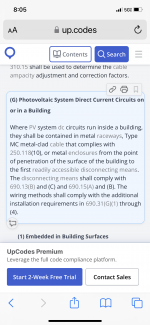dm9289
Industrial Maintenance Electrician
- Location
- Pennsylvania
- Occupation
- Industrial process repair/ maintenance Electrician
I’m having a problem understanding 690.31g.
Example conduit running outside house then goes in attic to roof.
So from inverter can you run PVC to attic entry then switch to EMT at the house penetration with a metal box and bond?
I have heard it said no PVC for DC but I don’t believe that is code.
Helpful explanation would be appreciated.
Example conduit running outside house then goes in attic to roof.
So from inverter can you run PVC to attic entry then switch to EMT at the house penetration with a metal box and bond?
I have heard it said no PVC for DC but I don’t believe that is code.
Helpful explanation would be appreciated.


